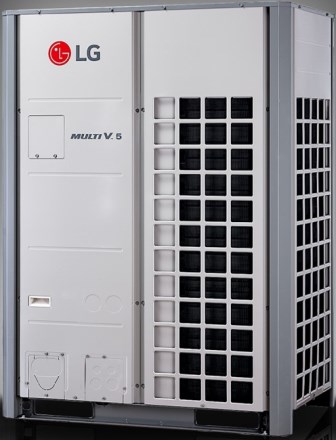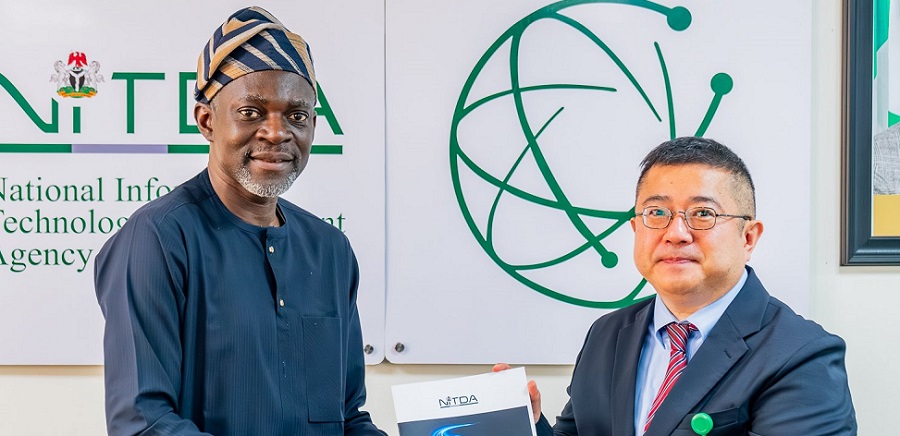E-Business
LG Electronics Offers Smart HVAC Solution for African Market

Companies that provide heating, ventilation and air conditioning (HVAC) solutions know it’s crucial to offer products that meet the climate control needs of the respective audiences.
LG Electronics has its Multi V system available in the African markets and representatives say it’s ideal for the region, especially considering that some areas get temperatures upwards of 120 degrees Fahrenheit.

LG design its Multi V unit to address the needs of commercial clients, such as apartment building managers or people who oversee office complexes.
Customizable Coolness for Each Room
The Multi V is a variable refrigerant flow (VRF) system, which means it uses refrigerant for both heating and cooling purposes. A VRF system has an outdoor condenser unit, then an indoor unit in each room requiring climate control.
Manipulating the flow of refrigerant solution through the evaporator coils of the indoor units keeps each room at the desired temperature while using less energy than traditional systems that circulate chilled air or water through ducts in a building.
VRF systems still rely on air or water for cooling, but the changeable flow of the refrigerant results in energy-saving benefits. More specifically, they are 20-30% more efficient than conventional HVAC systems.
Standout Qualities of the System
Besides Multi V being a VRF system offering the benefits above, LG engineered specific perks that make these HVAC systems superior to others available to buy.
The LG Multi V family of products includes numerous units, and the brand calls attention to the high-tech inverters. They provide maximum efficiency at both full and partial loads.
Additionally, LG discusses the Multi V as a “total HVAC solution.” Many of the notable qualities of the system relate to its sensor technology.
For example, there is a dual sensing control that detects both the temperature and humidity in the environment and adjusts accordingly.
And, the data from the temperature and humidity sensors relates to a smart load control feature that manages the cooling load for increased energy efficiency based on the conditions.
There is also a Comfort Cooling setting. Once an operator activates it, the system transitions into a “mild cooling” mode without stopping to switch to the lower setting.
Suitable for the Smart Energy Trend
As mentioned earlier, some of the countries within the African and Middle Eastern markets set energy efficiency targets to meet within approximately the next decade. LG believes its Multi V technology will be instrumental in helping those nations reach their goals, particularly because it uses smart technology.
Smart HVAC systems collectively represent one of the top trends in the HVAC industry at large. Residential and corporate customers alike appreciate them since the intelligent aspects of such a setup offer benefits such as repair notifications that let users know when it’s time to make service calls.
Some units even schedule those appointments automatically. Also, sensors, like the ones LG incorporates into its units, enable self-regulation of HVAC units. They trigger the equipment regarding when and where to operate in a building.
Compatible With a Smart Energy Interface
Customers using a Multi V HVAC system can take advantage of a complimentary intelligent system called Building Energy Control, or BECON. There are reportedly several sites in the Middle Eastern and African regions using BECON for smart energy management. BECON is a cloud-based, Internet of Things (IoT) platform.
Its energy scan feature takes data from all the respective sensors and gives detailed energy usage statuses related to a building’s zones, floors or other parameters. It can also provide a future operation guide that instructs users on how to save energy while continuing to consider the comfort of the occupants.
BECON has diagnostic capabilities too. It looks at past and present data to spot abnormal patterns within it. The technology can also use that information to solve problems associated with equipment in a facility.
When BECON users want to see the impacts of various changes they could make to an HVAC system’s settings, BECON offers simulations that take things such as weather information, past usage and customer preferences about comfort versus efficiency into account.
Comfort and Conservation Combined
LG seems committed to offering its customers solutions that keep them comfortable in extreme temperatures without wasting energy. The Multi V is an excellent example of a system that incorporates several smart features that align with modern energy needs.
This system and others similar to it will likely continue to gain momentum, especially with a renewed focus on climate change mitigation and energy efficiency in many parts of the world.
Inside VRF HVAC Systems
At the heart of any building is its HVAC system—that essential collection of compressors, coils, fans, and controls that has such a hand to play in energy costs, air quality, and occupant comfort.
LG Air Conditioning Technologies understands this, and when it comes to perfecting all three, it’s hard to beat their LG MULTI VTM VRF series.
VRF—or Variable Refrigerant Flow—systems differ from traditional HVAC solutions in a few key ways. Most importantly, their fans and compressors run on inverter motors attached to computerized control systems, meaning their speed can be precisely controlled.
In essence, rather than merely flipping on and off like a typical AC unit, the inverter technology enables VRF systems to respond in real-time to changing conditions in a space and adapt accordingly.
“Imagine a time when you reached for your thermostat to shut off a blast of frigid air only to find the room too warm five minutes later.”
VRFs can even use heat recovered from one room to warm another, an ability that makes for particularly energy-efficient operations in hospitality settings and multi-family housing.
A VRF system is up to the task when it comes to pricing, VRF systems may initially appear more expensive, but when life-cycle energy savings and total building expenditures are taken into account, they quickly prove themselves to be the more affordable option.
Take, for example, the construction costs incurred by a chilled water system, which requires heavy structural steel and concrete in order to support, or the ductwork utilized by a simple rooftop system, which can take up two to three feet of space between each floor of a building.
By contrast, a typical refrigerant line used by a VRF is a mere two to three inches in diameter, allowing for significantly greater architectural flexibility.
With the superior performance, comfort, and energy savings VRFs offer, General Manager of the Air Solution Division, LG Electronics West African Operation, Mr. Jung June Yoon says they’re a bit like the Ferraris of the HVAC world—streamlined, powerful, and flawlessly engineered.
E-Business
FG Launches Online Visa Approval Centre

Dr. Olubunmi Tunji-Ojo, minister of Interior, has announced the launch of an Online Visa Approval Center to eliminate bureaucratic bottlenecks and reduce corruption in the visa application process.

Commissioned by the President in December, the new system ensures that applicants no longer need to visit a visa office, know anyone in the system, or lobby for approvals.
At a stakeholders’ sensitisation workshop on the implementation of the Nigeria Visa Policy (NVP) 2025, yesterday in Abuja, Dr. Tunji-Ojo said the visa is considered a very important document by the government because it is an instrument of migration management and an instrument of economic development.
The minister explained that Nigeria has to strike a delicate balance between national security and, of course, the ease of migration.
“And we think that it’s something that we can do and something we will do.
“We don’t have a physical Visa Approval Center. If you apply for a Nigerian visa anywhere in the world, you do so online. We process it here in Nigeria, and if approved, you receive your e-visa in your email,” he explained.
To enhance efficiency, the government has set a 48-hour deadline for processing e-visas.
“It is unprofessional and unacceptable for the Nigeria Immigration Service not to approve or provide feedback within 48 hours,” the minister stated.
“It breaks my heart that people need to lobby to even get visas to Nigeria. It shouldn’t be so. It shouldn’t be.
“For anybody that is qualified, for anybody that wants to do legitimate activities in Nigeria, such people should be able to come to Nigeria easily. And this is why we are opening our space. Mr. President is interested in foreign direct investments.”
Further, he said Nigeria is interested in partnering with the rest of the world to develop its economy but, “We can’t do that when we allow bottlenecks to hold us down. So these reforms, basically, are aimed at opening our space, enhancing national security, and we hope that the primary responsibilities of the visa scheme will be achieved.”
Kemi Nandap, controller general, Nigeria Immigration Service (NIS), said the NIS would fully digitize its e-visa platform and reduce visa classifications from 79 to 44 to enhance accessibility, transparency, and efficiency in the new visa policy.
She said, “At the core of this policy is the new e-visa platform—a fully digitized, centralized system that revolutionizes how foreign nationals interact with our country’s entry procedures. As part of this transformation, the Nigerian Visa Policy 2024 underwent a comprehensive review, resulting in a significant reduction in visa classifications from 79 to 44.
“These categories have been logically grouped to simplify procedures, reduce complexities, and greatly improve the user experience. Importantly, we have maintained the original purpose and intent of each visa class throughout this reform.”
E-Business
NITDA Partners JICA to Launch Nigeria-Japan Startup Hub

Mr. Takao Shimokawa, director general, Economic Development Department at the Japan International Cooperation Agency (JICA) has visited the National Information Technology Development Agency (NITDA) to discuss the forthcoming launch of the Nigeria-Japan Startup Hub Project.

Mr. Dejo Olawunmi, director of IT Infrastructure Solutions at NITDA and Mr. Takao Shimokawa, director general, Economic Development Department at the Japan International Cooperation Agency (JICA)
This is in a strategic move to strengthen Nigeria’s startup ecosystem.
During his visit, Mr. Shimokawa was received by Mr. Dejo Olawunmi, director of IT Infrastructure Solutions at NITDA.
Their discussions focused on advancing technological innovation, fostering entrepreneurship, and enhancing venture capital development to support early-stage startups in Nigeria.
The Nigeria-Japan Startup Hub Project is designed to provide Nigerian startups with access to Japanese expertise, mentorship, and investment opportunities.
The initiative aims to create a collaborative environment where local entrepreneurs can scale their businesses by leveraging Japan’s advanced technology and business models.
By bridging Nigerian startups with Japanese investors and industry leaders, the project seeks to drive sustainable growth and innovation in Nigeria’s tech industry.
This partnership underscores the increasing economic and technological cooperation between the two nations, positioning Nigeria as a key player in the global startup landscape.
With the hub set to launch soon, stakeholders anticipate that it will provide critical resources for startups, enabling them to compete in the global market and contribute to Nigeria’s digital economy.
E-Business
Firm Discovers Sophisticated Chrome Zero-day Exploit Used in Active Attacks

Kaspersky has identified and helped patch a sophisticated zero-day vulnerability in Google Chrome (CVE-2025-2783) that allowed attackers to bypass the browser’s sandbox protection system.

The exploit, discovered by Kaspersky’s Global Research and Analysis Team (GReAT), required no user interaction beyond clicking a malicious link and demonstrated exceptional technical complexity. Kaspersky researchers have been acknowledged by Google for discovering and reporting this vulnerability.
In mid-March 2025, Kaspersky detected a wave of infections triggered when users clicked personalised phishing links delivered via email. After clicking, no additional action was needed to compromise their systems.
Once Kaspersky’s analysis confirmed that the exploit leveraged a previously unknown vulnerability in the latest version of Google Chrome, Kaspersky swiftly alerted Google’s security team. A security patch for the vulnerability was released on March 25, 2025.
Kaspersky researchers dubbed the campaign “Operation ForumTroll”, as attackers sent personalised phishing emails inviting recipients to the “Primakov Readings” forum. These lures targeted media outlets, educational institutions, and government organisations in Russia.
The malicious links were extremely short-lived to evade detection, and in most cases ultimately redirected to the legitimate website for “Primakov Readings” once the exploit was taken down.
The zero-day vulnerability in Chrome was only part of a chain that included at least two exploits: a still-unobtained remote code execution (RCE) exploit that apparently launched the attack, while the sandbox escape discovered by Kaspersky constituted the second stage. Analysis of the malware’s functionality suggests the operation was designed primarily for espionage. All evidence points to an Advanced Persistent Threat (APT) group.
“This vulnerability stands out among the dozens of zero-days we’ve discovered over the years,” said Boris Larin, principal security researcher at Kaspersky GReAT. “The exploit bypassed Chrome’s sandbox protection without performing any obviously malicious operations – it’s as if the security boundary simply didn’t exist.
The technical sophistication displayed here indicates development by highly skilled actors with substantial resources. We strongly advise all users to update their Google Chrome and any Chromium-based browser to the latest version to protect against this vulnerability.”
Google has credited Kaspersky for uncovering and reporting the issue, reflecting the company’s ongoing commitment to collaboration with the global cybersecurity community and ensuring user safety.
Kaspersky continues to investigate Operation ForumTroll. Further details, including a technical analysis of the exploits and malicious payload, will be released in a forthcoming report once Google Chrome user security is assured.
Meanwhile, all Kaspersky products detect and protect against this exploit chain and associated malware, ensuring users are shielded from the threat.
This discovery follows Kaspersky GReAT’s previous identification of another Chrome zero-day (CVE-2024-4947), which was exploited last year by the Lazarus APT group in a cryptocurrency theft campaign.
In that case, Kaspersky researchers found a type confusion bug in Google’s V8 JavaScript engine that enabled attackers to bypass security features through a fake cryptogame website.

 News2 days ago
News2 days agoCourt Throws Out Falana’s Fraud Case against Ekeh, Zinox Boss and Others

 E-Financial2 days ago
E-Financial2 days agoHeritage Bank Depositors Seek National Assembly’s Help to Recover Trapped Funds

 Telecom2 days ago
Telecom2 days agoNokia Unwraps 5G Gateway for Home Internet

 News2 days ago
News2 days agoFG Receives N1Bn Grant from Airtel Africa to Boost 3MTT Programme

 News2 days ago
News2 days agoFG to Halt Solar Panel Imports, Pushes for Local Manufacturing

 E-Business2 days ago
E-Business2 days agoSenate Passes Bill to Re-enact NIMC Act

 Telecom1 day ago
Telecom1 day agoAgain, Labour Fumes, Threatens Shutdown of Telcos over Non-Implementation of 15 Percent Tariff Reduction

 E-Business1 day ago
E-Business1 day agoQNET Disassociates From Fraudulent Academy in Abuja, Supports EFCC Arrest



























